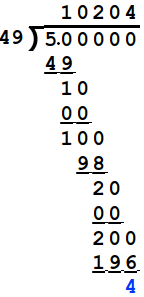At a family dinner, my brother told me that he had stumbled upon a curious number. Divide five by forty-nine and take a look at the digits:
$$5 / 49 = 0.10204081632653061…$$
Do you see a pattern in the digits? Yes! It’s powers of two: (0.)1, 02, 04, 08, 16, 32, 65, … Huh, 65? Yes! The next number, 128, is a three-digit number and so the first digit “overlaps” the last digit of 64, making it 65. And this continues for the first digits of 256 (28 + 2 = 30), 512, the first two digits of 1024, etc. Then floating point errors kicked in, and we stopped there.
I immediately googled it, but no one seems to have noticed this pattern in the digits before. It began to dawn on us that we may just be looking at a hitherto undiscovered “interesting number” such as pi, e, the golden ratio, etc. But the social norms of family meetings do not allow for simulations and mathematical derivations, so we put it aside.
Simulations
The number kept lingering in the back of my head. A few weeks later, I had several pressing deadlines, and as usual, procrastination kicked in full force. I needed to see how far this sequence continued. I fired up Python and wrote a small script which generates the power sequence first, then calculates the number 5/49, and finally identifies at what decimal place the two diverge:
# Power of two to evaluate up to
max_power = 20
# Generate the perfect 102040... sequence in integers instead of decimals
# to avoid floating point errors
power_decimals = 0
for i in range(max_power+1):
trailing_zeroes = 10**(max_power*2 - i*2)
power_decimals += trailing_zeroes * 2**i
print('0.%41d' %(trailing_zeroes * 2**i), '2^%i'%i)
power_number = '0.%i' %power_decimals # Add "0."
print(power_number, 'Power')
# Print 5/49 without floating point errors
from decimal import Decimal, getcontext
getcontext().prec = max_power*2+1
fraction = str(Decimal(5) / Decimal(49))
print(fraction, 'Fraction')
# Compare them digit for digit: when do they diverge?
for i in range(len(fraction)):
if fraction[i] != power_number[i]:
print('Identical until decimal %i' %(i - 2)) # Don't count "0." as decimals
break
The print-function in the first for-loop visualizes the adding of the power sequence:
0.10000000000000000000000000000000000000000 2^0 0. 200000000000000000000000000000000000000 2^1 0. 4000000000000000000000000000000000000 2^2 0. 80000000000000000000000000000000000 2^3 0. 1600000000000000000000000000000000 2^4 0. 32000000000000000000000000000000 2^5 0. 640000000000000000000000000000 2^6 0. 12800000000000000000000000000 2^7 0. 256000000000000000000000000 2^8 0. 5120000000000000000000000 2^9 0. 102400000000000000000000 2^10 0. 2048000000000000000000 2^11 0. 40960000000000000000 2^12 0. 819200000000000000 2^13 0. 16384000000000000 2^14 0. 327680000000000 2^15 0. 6553600000000 2^16 0. 131072000000 2^17 0. 2621440000 2^18 0. 52428800 2^19 0. 1048576 2^20
and the other print functions compare the “ideal” number to the fraction:
0.10204081632653061224489795918367346917376 Power 0.10204081632653061224489795918367346938776 Fraction Identical until decimal 36
Ok, wow, so it goes on for quite a while. Setting max_power = 10.000 and…
Identical until decimal 16992
Now I’m convinced that this is an infinite pattern. But it gets even better: the sequence starts over every 42 digits. I repeat: Every. 42!!! Digits. Here are the first 168 decimals:
5/49 = 0. 102040816326530612244897959183673469387755 102040816326530612244897959183673469387755 102040816326530612244897959183673469387755 102040816326530612244897959183673469387755...
Is the key to the universe hidden in there somewhere!!?? I was exploding with excitement when I ran and presented this to my wife late in the evening.
The math
My wife is a mathematician. She was not impressed. “Jonas, do you know how to divide five by forty-nine by hand?”. No, I must admit that I never properly learned to do long division (even though I later enjoyed doing long polynomial division). And sure enough: the remainder of the first operation is 50-49 = 1. The remainder of the second operation is two decimal places further to the right where 1 is 100, and the equation becomes 100 – 98 = 2. Then two further to the right and doubling again: 200 – 196 = 4. Then 400 – 392 = 8, etc.

Every 21 such operations the division again hits the operation 50/49, and it repeats. This is extremely common for integer fractions in general. In fact, all rational numbers either have repeating decimals (like 5/49) or terminate (like 1/4 = 0.250000…), so one should not be surprised. Also, this particular 42-decimal period is shared by the division of 42 different integers by 49, albeit starting at different locations in the sequence, e.g., 1/49=0.02040816… and 3/49=0.06122448….
My wife went to bed. For a few seconds, I felt bad. My intellectual love affair crashed hard upon realizing that 5/49 was in many respects just a normal number. But as with human relationships, so with numbers: I’ve learned a great deal about rational numbers through this journey and that’s a comfort.
Conclusion
I do still think that 5/49 stands out. A 42-decimal period with powers of two is an intriguing property only shared by x/49 fractions. Furthermore, 5/49 is the only one of these fractions to start at 20=1 – the true beginning of the power sequence.
The long-division property can be exploited to generate numbers with custom power-sequences in the decimals. So without further ado, I give you:
$$10/(10^n-x)$$
… where x ∈ R≥0 is the root of the exponential and n ∈ N≥2 is the number of decimal places between each number. Let’s try this for a few numbers:
10/(10^4 – 3) = 0.00100030009002700... # Powers of three with four spaces 10/(10^3 - 2) = 0.01002004008016032... # Powers of two with three spaces 10/(10^2 - 4) = 0.10416666666666667... # Powers of four rises too quickly for two spaces 10/(10^3 - pi) = 0.0100315149336198... # Powers of pi, just for fun.
For two decimal places between powers of two, we get
$$10/(10^2 – 2) = 10/98 = 5/49$$
I hope that this number will henceforth be known as Lindeløv’s number. At least it’s on Google now.